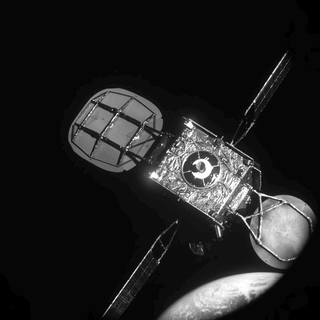Ailing Intelsat satellite begins new life in orbit after historic servicing mission success
It's one giant leap for satellite servicing tech.

"Can I get a boost?" has officially made it to space.
The first commercial satellite servicing mission has been declared a success after the Intelsat 901 (IS-901) communications satellite returned to work providing internet connectivity.
The satellite, which launched in 2001, had been running low on fuel needed to maintain its correct orbit. But rather than launch a replacement internet satellite, its owner, Intelsat, hired Northrop Grumman to conduct a first-of-its-kind mission. That project sent another satellite, called Mission Extension Vehicle 1 (MEV-1) to connect to IS-901 in February and take responsibility for keeping the internet satellite in the proper location to do its job.
Related: Two private satellites dock in space in historic 1st for orbital servicing
"We see increased demand for our connectivity services around the world, and preserving our customers' experience using innovative technology such as MEV-1 is helping us meet that need," Intelsat Chief Services Officer Mike DeMarco said in a Northrop Grumman statement released today (April 17).
That statement confirmed that MEV-1 has successfully latched onto IS-901 and maneuvered it back to its proper orbit, and that the internet satellite is again providing services to Intelsat customers.
MEV-1 will now spend five years attached to IS-901 to extend that satellite's tenure. After the contract ends, MEV-1 will steer the old satellite to a safe orbit, detach, and join up with a different satellite to provide the same services. MEV-1 should be able to partner with satellites for a total of 15 years, according to a previous Northrop Grumman statement.
Get the Space.com Newsletter
Breaking space news, the latest updates on rocket launches, skywatching events and more!
Northrop Grumman is planning to launch a second mission-extension vehicle later this year, which will also aid an Intelsat satellite.
"This historic event, highlighted by the first in-orbit rendezvous and docking of two commercial satellites and the subsequent repositioning of the two-spacecraft stack, demonstrates the business value that MEV offers to customers," Tom Wilson, vice president of Northrop Grumman Space Systems, said in a statement. "Now that MEV-1 has successfully delivered on its mission to place the Intelsat 901 satellite back into operational service, we will continue to pioneer the future of on-orbit servicing through our multi-year technology roadmap leading to additional services such as inspection, assembly and repair."
- First-of-its-kind satellite servicing spacecraft launches on Russian rocket
- Robotic satellite servicing spacecraft — MEV-1 explainer
- Two commercial satellites dock in orbit for first time
Email Meghan Bartels at mbartels@space.com or follow her @meghanbartels. Follow us on Twitter @Spacedotcom and on Facebook.
OFFER: Save 45% on 'All About Space' 'How it Works' and 'All About History'!
For a limited time, you can take out a digital subscription to any of our best-selling science magazines for just $2.38 per month, or 45% off the standard price for the first three months.
Join our Space Forums to keep talking space on the latest missions, night sky and more! And if you have a news tip, correction or comment, let us know at: community@space.com.

Meghan is a senior writer at Space.com and has more than five years' experience as a science journalist based in New York City. She joined Space.com in July 2018, with previous writing published in outlets including Newsweek and Audubon. Meghan earned an MA in science journalism from New York University and a BA in classics from Georgetown University, and in her free time she enjoys reading and visiting museums. Follow her on Twitter at @meghanbartels.
-
Trixlette2 They need to use that technology to start removing all those satellites up there that no longer work, and charge the places that launched them with the recovery price.Reply
" About 1,100 active satellites, both government and private. Plus there are about 2,600 ones that no longer work. " -
Lovethrust ReplyTrixlette2 said:They need to use that technology to start removing all those satellites up there that no longer work, and charge the places that launched them with the recovery price.
" About 1,100 active satellites, both government and private. Plus there are about 2,600 ones that no longer work. "
The satellite they refueled was way up in geosynchronous orbit. Those satellites are too high up to be practically moved to burn up in the atmosphere. They are moved to a parking orbit higher up when there lives are over and they are not hazards as there is a lot of space up there. As for the lower orbits there is a lot of junk that needs to be cleared. Fortunately modern sats leave enough fuel so they can deorbit themselves at the end of their lives.

